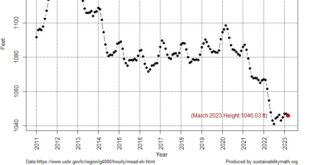A 2016 article in Nature, The world’s road to water scarcity: shortage and stress in the 20th century and pathways towards sustainability by M. Kummu et. a., looks at water scarcity and shortages (The dotted red line in the graph copied here is the proportion of the population dealing with water scarcity issues. )
Due to increasing population pressure, changing water consumption behavior, and climate change, the challenge of keeping water consumption at sustainable levels is projected to become even more difficult in the near future5,6.
The increases in population and per capita water consumption resulted in a total water consumption increase from 358 km3 yr−1 in the 1900s to 1500 km3 yr−1 in the 2000s (Fig. 1B).
The article has 6 figures and two data sets available (under electronic supplementary material – right side bar). The richness of the figures makes them useful in a QL or stats course.
A related article from National Geographic, The world’s supply of fresh water is in trouble as mountain ice vanishes by Alejandra Borunda (12/9/2019), discusses the impact of climate change on water supplied by glaciers.
The high mountains cradle more ice and snow in their peaks than exists anywhere else on the planet besides the poles. Over 200,000 glaciers, piles of snow, high-elevation lakes and wetlands: All in all, the high mountains contain about half of all the fresh water humans use.
The high mountains are warming faster than the world’s average; temperatures in the high Himalaya, for example, have crept up nearly 3.6 degrees Fahrenheit (2 degrees Celsius) since the beginning of the century, compared to a planetary average of just about 1.8 degrees F (1 degree C).
“120 million people live along the Indus,” says Immerzeel, “but the Indus plain is like a desert. It’s completely reliant on the water from the thick glaciers above.”
Of the five most important water towers in the world, three are in Asia: the Indus, the Tarim, and the Amu Darya.

